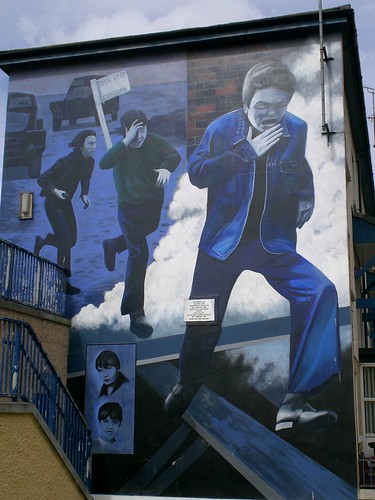Post and photos by Sarah J. Magan

The Petrol Bomber: Derry, Northern Ireland
This mural depicts some scenes from the “Battle of the Bogside” in August 1969. The mural depicts a young boy wearing a gas mask to protect himself from the CS gas that the British Army used on residents of the Bogside. In his hand is a petrol bomb. There is a real photograph of a young boy with a gas mask and petrol bomb in the Bloody Sunday Museum in Derry.
The historically popular and significant street art of Northern Ireland has the power to stir a soul. One of my final courses at Saint Joseph’s University called Violence and Reconciliation: Northern Ireland Immersion took me on an amazing two week journey through Northern Ireland. Our course looked at conflict and the effects of conflict in our world by using Northern Ireland as a case study. Prior to our immersion, we read literature written by Northern Irelanders and studied philosophers who dealt with issues of social recognition and the affect of that on the formation of society and conflict within society. As an art student, I made it my business to explore and photograph as many murals as I could while I was in the country. [Ed. note: See more of Sarah’s mural photos at her flickr site.]

There are almost 4000 murals throughout Northern Ireland. Each mural tells a specific story related to true historical events, cultural themes, religious displays, or political leanings. Northern Ireland murals are left up for a period of time and then photographed and painted over. With the recent peace talks and reopening of Parliamentary action, the content and affect of murals are becoming big political questions. Many people I encountered during my time there, no matter what religious or political affiliation, had mixed feelings about the murals. Most people thought they were beautiful; I even had one cab driver refer to the murals as “wonderful pieces of art work.” But the violent nature of many of them has proven to have detrimental effects on the communities where these types of murals hang.

Loyalist Paramilitary Mural: Belfast, Northern Ireland
Murals are supposed to be a community decision and project; however I found that many community members, both Catholic and Protestant alike, were forced to approve the placement of murals in their communities under threat of violence from local paramilitary operations. However, many murals do unite individual communities around the country, but it is the type of unity and the actions behind that unity that are now being called into question. In certain areas of Belfast, the murals have bonded communities together in a negative way because of the violence and hatred they display, thus reinforcing hundreds of years of conflict in that society. Communities such as this are producing more violence than in areas where the violent murals have been painted over and changed to more cultural themes.

Liam MacCarthy: Belfast, Northern Ireland
This is a more “cultural” mural that is painted along a stretch of wall that has a number of other murals on it with themes that range from the Troubles to Palestine to America in Iraq.
Much of this information I heard before I saw what believed to be the most fear-instilling. Before viewing some of these murals in Belfast, I believed that the murals shouldn’t come down – you know the whole “art and history should be preserved” thing. But after seeing the violence and intimidation portrayed on those walls, I am not so sure whether or not I would want them to remain. The culture of violence that has been built up in the country has had art as an aid in that negative growth. The public art in Northern Ireland raises important questions about the formation of conflict in our own country. What effects is graffiti having on the formation of gangs, violence, and drug use in our communities? If there were murals of the violent, religious, and politically driven nature in Philadelphia instead of the culturally rich content that we see around the city daily, how would the behavior of society be different?
— Sarah is a photographer who recently graduated from Saint Joseph’s University.






